Can Drones Fly in Rain? Tips and Ways
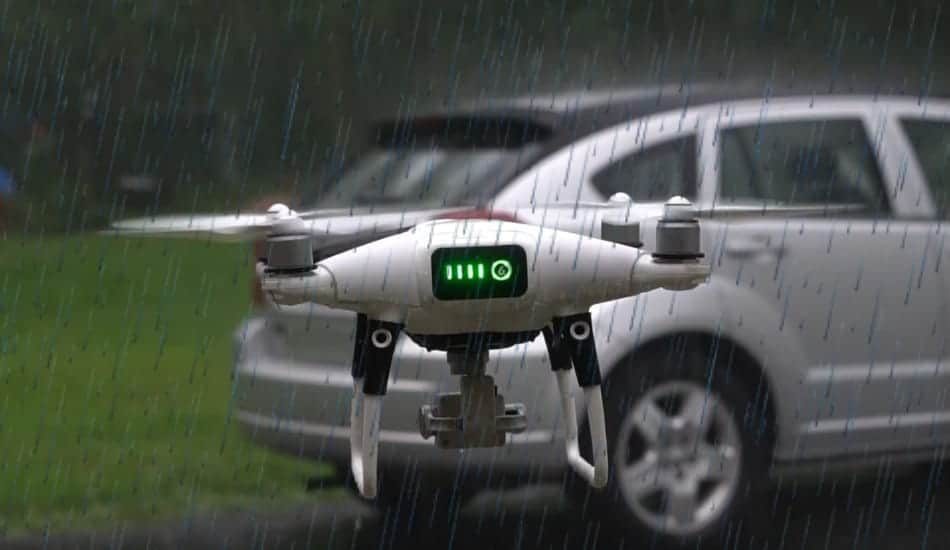
Do you check the weather more carefully than usual before you fly a drone? The weather is the greatest enemy for drones. If I can fly my drone in the rain, how clever it really is, because drones are made up of electronics after all. Therefore, this time, in addition to the typical bad weather such as rain and strong wind, you must be aware of how to safely fly a drone. There are a few questions we need to ask ourselves. Certainly planes and helicopters can fly even if it rains, but what about drones? So i decided to find out can drones really fly in the rain.
So Can Drones Fly in Rain? The majority of drones are not designed and adapted to be used in the rain. The motors are in the open air and can quickly be damaged if they come into contact with water. The engines could stop and cause a crash. However, there are waterproof drones that can fly in the rain. Many current drones are not waterproofed.
Flying in the rain is not recommended also for a couple of more reasons. Because the visibility is poor, because the electronics don’t like being wet, neither that on board a drone nor that of a smartphone and a radio control. These recommendations being recalled, you may still want to fly in the rain.
What Happens When You Fly a Drone in The Rain
Here we will show you a real example how drones react to the rain. The drone (Spark) jumps out of the heavy rainfall where you can see the raindrops, and Spark continues to be hit by rainwater . After landing, you can see how drone looks like. A drone can fly even in the rain. DJI drones are amazing. The Spark was able to fly after that heavy rain. Drones are machines. In this experiment video, he keeps flying a drone (Spark) for several minutes in the rain. This drone can be operated using a smartphone as a remote control , but the smartphone that was operated in the rain breaks down first. Even smartphones will not work if submerged. Nevertheless, drones continue to fly and are clever enough to land automatically due to battery drain.
https://www.youtube.com/watch?v=-LaHDW67sF8
Potential Risks When Flying a Drone in The Rain
A simple drop of water is enough to create a short circuit between two pins of an integrated circuit to destabilize the best drone. The fairing protects the circuits, of course, but the saturated atmosphere and the fact that the circuits heat up produce condensation. During flight, the drone body generates heat. In order to efficiently release the heat, it is necessary to adopt a structure with many gaps. Furthermore, because drone has a camera, it can be said that camera is also vulnerable to water. The camera function is still good, but the worst case can be expected if rain enters the drone during flight. After all, flying on a rainy day seems very dangerous. It is necessary to pay attention not only to rain but also to sand during takeoff and landing. Due to drone shooting, there are times when it is unavoidable to take a picture even in bad weather. That said, instead of letting the drone fly in the rain, we shot with the drone when the rain stopped.
Risks of Drone in The Rain:
- If the drone gets wet in the rain, there is a risk of breakdown and the risk of crash increases
- Battery could short circuit and catch fire, causing crash
- Even when shooting in the rain, the lens has raindrops and cannot be taken beautifully
How to Predict Rain?
Today it is very easy to check if there will be rain or not. With great accurately you can have full weather report, and all this is at our fingertips. All this information can be found on various websites or applications that you can download for free on your mobile. One of the most popular applications currently available for quality forecasting are: AccuWeather, Dark Sky, Weather Underground and Carrot Weather. So, before you decide to take the drone in your hands, download the application to your mobile device and check the weather and the possibility of rain. Most of these applications show accuracy of over 95% because they are using satellite technology, and the errors are very small.
How to Fly Your Drone in the Rain?
There is something called “Wet Suit” and it is used to protect the drone in the rain. Brushless motors are not very sensitive to humidity, and they can even, for short periods, operate submerged. So the rest of the electronics are at risk in the presence of moisture. In this case, DJI’s Phantom and Mavic devices, the on-board electronics are particularly protected by the fairing. Water can still enter through a few openings for heat dissipation. The Phantom Rain solution helps limit the risk of water entering the device.
Wet Suit for Drones
Phantom Rain protections, called Wet Suits. They are made of neoprene, weigh less than 10 grams and do not require tools to be installed. They cover a large part of the drone where there are joints. The protected parts are: the battery compartment, the arms, the base of the propeller shaft.
The creator of the Wet Suits assured us that there was sufficient ventilation. Moreover, the Wet Suits do not make drones waterproof, there are vents which are not protected to, precisely, ensure this ventilation. But their position limits the risk of penetration of liquids. Should I remove a Wet Suit after a flight? No, according to its creator, it can stay in place all the time. Filming with a drone in the rain, is that ridiculous. If you have already flown in the rain or in the snow, you will have noticed that it is easy to prevent drops of rain from settling on the lens by orienting the camera back to the wind and tilting the camera a little. The Wet Suits are available in several colors for for certain drone models, such as the Phantom 4, Phantom 4 Pro, Phantom Advanced, Mavic Pro, Platinum, Mavic 2 Pro and Zoom etc.
> Check Price, reviews and pics <
https://youtu.be/fMmHr6O8AHk
Does The Law Allow You To Fly Drone In The Rain
The law, or aviation law, does not actually restrict drone flight in rainy weather unless it is an uncontrolled area and method of flight. However, as guidelines to be followed, the Ministry of Land, Infrastructure, Transport and Tourism guidelines state that:
„Before flying, unmanned aerial vehicles are susceptible to the effects of wind, etc.
Check if the weather conditions allow safe flight. Check if the drone is damaged or malfunctioning. Check if the battery is fully charged.“
It is said that you should fly the drone in “safe weather conditions”. However, in the case of densely populated areas or restricted flight methods, the absolute condition is “do not fly in rainy weather” in order to obtain a flight permit from the Ministry of Land, Infrastructure, Transport and Tourism. In other words, at this stage, drones cannot legally fly in rainy weather.
If Even a Single Rain Drops, Stop Drone Flight
It is possible to fly with your drone in the rain, but this is by no means advisable. A drone is a precious flying machine, and flying it in the rain is the same as using a computer or smartphone in the rain. Let’s take a closer look at what risks there are and why.
The drone includes a number of components, including a “motor” that drives the flight, a “battery” that enables long flight times, and a high-performance sensor that controls the attitude of the drone while being affected by the wind. This all is installed inside the drone. The drive system components have many holes and gaps in the fuselage to release the generated heat from inside the drone to the outside. With this structure, the drone is apt to be flooded by rain, so it is easy to cause troubles such as motor failure and short-circuit of the battery, and it will crash as it is, and in the worst case it will also be damaged by nearby people In some cases.
TOP 3 Waterproof Drones For Flying In Rain
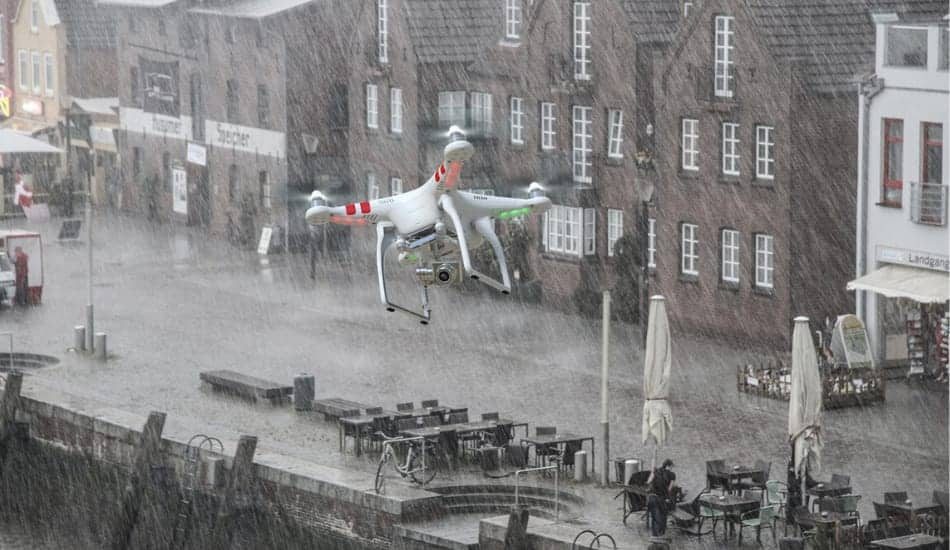
No matter how risky it may be, you may have to fly a drone in the rain. For such people, we recommend the drone the next 3 drones from our list. We have prepared articles that explain the features and fields of use from various angles, so if you are interested, please check it out.
1. Spry Drone
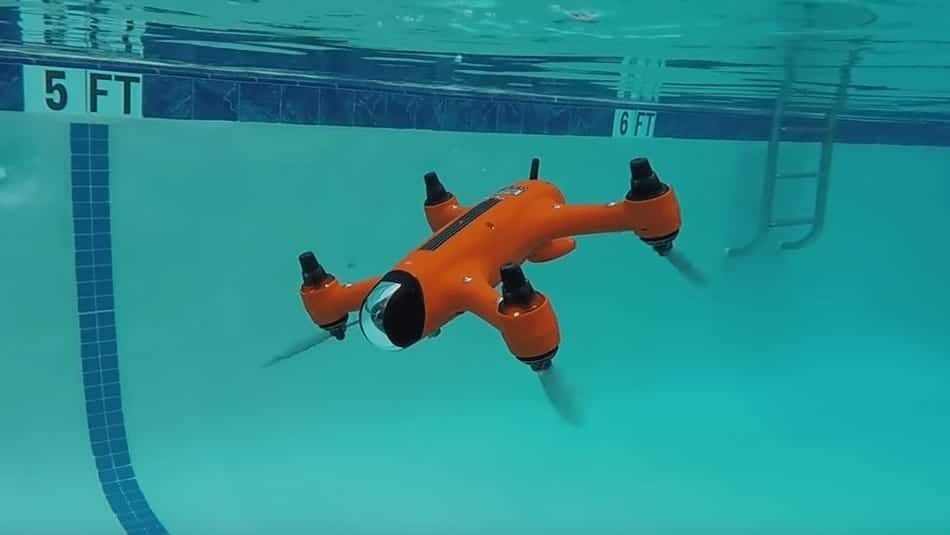
In light rain, the Spry Drone takes off as if nothing had happened. The motors are protected, as is the camera, enclosed in a polycarbonate dome. In addition to the weight of the chassis, this impermeability imposes a counterpart: the camera is not stabilized on the horizontal axis, resulting in a less fluid video image. To film in the rain, in truth, is of no great interest, except doubtless for certain professional uses, because the droplets are quick to blur the images transmitted on the screen of the radio control. The aircraft reacts well but, slightly heavy, it tends to lose altitude when it flies below 20 meters. But this drone is definitely a good choice.
> Check Price, reviews and pics <
2. Swellpro Splash Drone 3
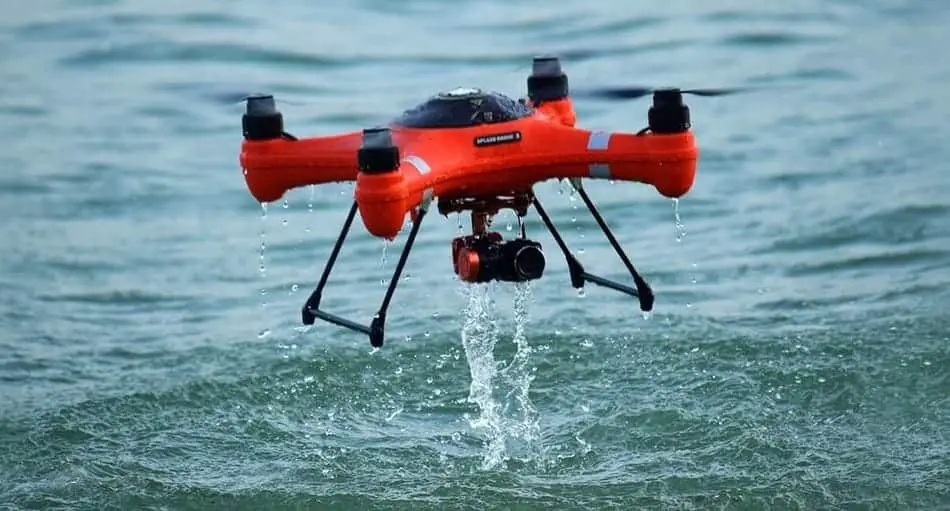
The basic principle pursued by the developers of Splash Drone 3 is ease of use. For a full flight, you do not need additional equipment, everything you need is in the base. Thanks to this, you can fly in almost any weather and land on water without fear of damaging the howling drone. A protected 4K camera will help you capture what is happening with high definition both in air and on water. The new Splash Drone 3 will come in two versions – Auto and Fisherman. The drone comes standard with a waterproof 4K camera and 2-axis gimbal, while Fisherman comes with a payload release system. However, cameras and payload modules can be quickly disconnected from the drone and swapped. Therefore, each drone can use any module. One charge of a lithium-polymer drone battery lasts for 16-18 minutes of flight. In the Auto version, if the battery level is extremely low, it will automatically land itself, wherever at the moment. Auto users can also activate the Home Return function using the remote control, in which the drone will automatically return to the take-off point.
> Check Price, reviews and pics <
3. Goolsky JJRC H31
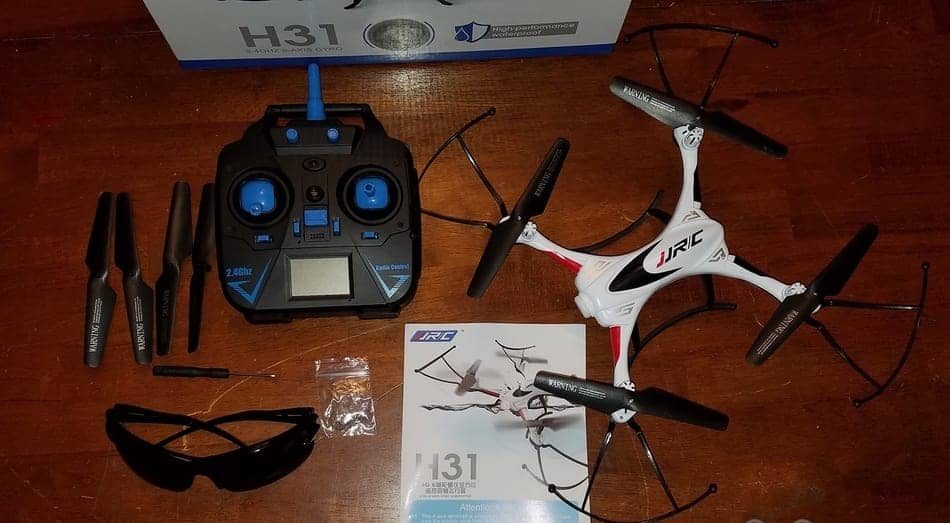
This drone is one of the latest models of the famous Chinese brand, which for many years specializes in toys operating on the radio. Children or adolescents from 8-14 years old will fully appreciate the capabilities of this quadrocopter, as well as suitable for adult beginners with the goal of first acquaintance with the UAV, which would subsequently turn their eyes to something more expensive and, accordingly, more interesting in this area of hobbies. The manufacturer offers two configuration options with and without a camera. You can choose from 2 cameras 0.3MP and 5MP. Shooting quality is below average. The emphasis of this drone is on flight and not on shooting. In any case, if you buy a drone without a camera, you can buy it at any time. In flight, the drone showed both good controllability and speed, especially in the Expert mode, and this is not surprising since the drone is very light less than 100g., and the motors, as mentioned above, have a power margin. So if you need a waterproof drone, this is a very great choice and quite cheap.
> Check Price, reviews and pics <
Flying a Drone in Other Weather Conditions
- Piloting in the snow: Driving in the snow is already less risky than in the rain. In a light snowfall, if the flakes are not huge, you can fly a drone. The air that is produced with the propellers prevents contact between the engines and the flakes. One of the biggest risks, however, is having a battery that is too cold. Do not expose the batteries to cold environment much before starting to pilot. Tip: make settings for the drone in the car or in an indoor location so that the batteries do not cool down too quickly.
- Piloting in the fog: It may seem less dangerous than rain or snow, but not at all! The condensation caused by the mist humidifies the drone. The risks are therefore the same as when driving in the rain
- Piloting in strong winds: Drones that have the hover mode allow the drone to stabilize and balance even during strong winds. There are still limits, a drone cannot fly during big storms. I therefore advise you to look at the user manual of your drone in order to see the maximum capacities.
- Piloting during solar storm: Solar activity produces geomagnetic storms that play a role in the quality of satellite signal reception. If this bad weather is overlooked enough, it is one of the most important. A solar storm is measured on a scale of 1 to 10 in Kp (Kepler index). It is strongly advised not to pilot a drone if the solar storm is higher than 5 Kp. You could lose your GPS signal and you would no longer have control of your drone.
Check Your Warranty
If you have a warranty for your drone, and if your drone is found to be defective due to moisture or water that has damaged the electronics inside it, you will not be eligible for a warranty. Well-known companies such as DJI consider this as “own responsibility” and you will not achieve anything with a warranty. So be careful and think about exposing your drone to rain.
Conclusion
Drones can fly in the rain, however, there is a risk of breakdowns and sudden crashes. Therefore drones cannot fulfill their full potential. Even if you fly in the rain, you can still create “things that make no sense to shoot“, because the camera is wet and cannot provide good quality photos and videos. The drone is made of electronics and is very sensitive to any rain and moisture. During a flight, ignoring the weather can lead to accidents such as failure, loss, or damage to a third party with a drone that you have purchased, so be careful before flying. Check the weather before! The instructions for use of drones, among others, stipulates in the precautions to be taken: do not fly your drone in rain, wind or snow. If I left out something or want to add, feel free to leave a comment below.

